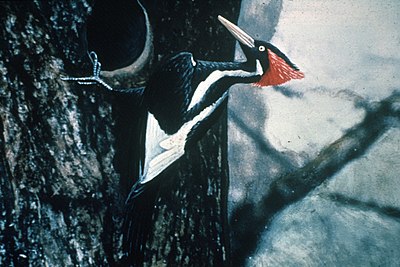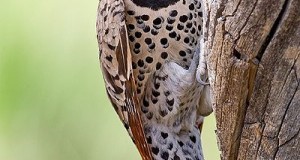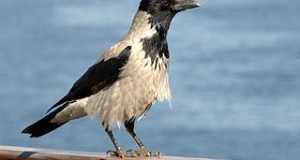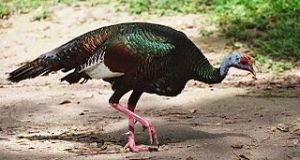 One of the USA’s most hotly-debated conservation questions seems finally to have been answered. For years, ornithologists have considered the huge Ivory-Billed Woodpecker, Campephilus principalis, to be extinct, but many well-respected biologists continued to report sightings. Down to an estimated 30 birds by the 1930’s, none had been observed for decades despite intensive searches and rewards, including one of $50,000 posted by the Cornell Lab of Ornithology. Recent video and acoustic recordings (Journal of the Acoustical Society of America, please see below), however, seem to establish that this magnificent bird is still with us.
One of the USA’s most hotly-debated conservation questions seems finally to have been answered. For years, ornithologists have considered the huge Ivory-Billed Woodpecker, Campephilus principalis, to be extinct, but many well-respected biologists continued to report sightings. Down to an estimated 30 birds by the 1930’s, none had been observed for decades despite intensive searches and rewards, including one of $50,000 posted by the Cornell Lab of Ornithology. Recent video and acoustic recordings (Journal of the Acoustical Society of America, please see below), however, seem to establish that this magnificent bird is still with us.
Confusion with the Pileated Woodpecker
A researcher from the US Naval Research Lab observed and recorded what appeared to be an Ivory-Billed Woodpecker as early as 2006. However, in common with other sightings, there was some confusion – the bird sighted could also have been a Pileated Woodpecker, which is similar in appearance to, and nearly as large as, the Ivory-Bill. It too favors the remote, flooded swamplands of the American Southeast (please see photo of typical habitat).
A Clue Over-looked for 70 Years
Video recordings of the bird were also contested, because certain unique characteristics in the Ivory-Bill’s wing-flapping style were missing. However, a careful review of earlier evidence led to an over-looked clue contained in a photo taken in 1939. With this new knowledge, woodpecker experts were able to determine that recent videos did indeed depict an Ivory-Billed Woodpecker.
Two audio recordings made along Louisiana’s Pearl River, which were consistent with videos taken at the same time, add weight to the evidence that this rarest of North American birds still holds on in small numbers. One of the videos was especially important as it was taken as a bird flew below a researcher, who was perched high in a cypress tree. This image reveals defining characteristics not captured in other photos of suspected Ivory-Bills.
Other Sightings
Researchers in Florida and Arkansas have also submitted evidence indicating that Ivory-Bills may survive in those states as well.
The Cuban Ivory-Billed Woodpecker, considered by some to be a subspecies of the North American, has not been sighted since 1987.
The Recovery Plan
 Once found in 13 states in the south-central and southern USA, this largest of all woodpeckers needs massive support if it is to survive. You can learn what is being done on it’s behalf in the US Fish and Wildlife Service’s Recovery Plan.
Once found in 13 states in the south-central and southern USA, this largest of all woodpeckers needs massive support if it is to survive. You can learn what is being done on it’s behalf in the US Fish and Wildlife Service’s Recovery Plan.
Further Reading
Ivory-Bill information, recordings and photos
Article mentioned above, including latest recordings of the Ivory-Bill’s call.
Ivory-billed woodpecker image referenced from wikipedia and originally posted by Jerry A Payne
Morava’s flooded forest image referenced from wikipedia and originally posted by Doronenko
 That Bird Blog – Bird Care and History for Pet Birds
That Bird Blog – Bird Care and History for Pet Birds




Hallo Frank
I am so happy for this conformation!It seems almost that if we keep on we will find the dodo again…LOL. Sorry, bad joke, but I am really glad for this woodpecker being re-found! And such a splendid looking bird!
One question; why is it that so many woodpeckers have red hoods? Could it be the same reason maybe that the house sparrows have the dark “collars”…the best colored one would be the guy with the strongest genes…?
Hello Gert, Frank Indiviglio here.
Thanks..yes, such a spectacular bird. As you say, surprises are out there. So many are extinct or near-to, of course, I’m always hesitant to accept that as a verdict. Years ago, when Tibet’s Giant Flying Squirrel was declared extinct, I had doubts. It is massive for a flying squirrel (more than 1 meter/almost 4 feet long) but still – a secretive , entirely nocturnal rodent that inhabited remote mountain ranges (mostly above tree line, glides from rock to rock). Well, finally one researcher offered money to locals within its range (which should always be the first move in such cases!) and he had 3 within a day or so; people knew many caves where they slept, and had long used its dried urine as a medicine; a look at eagle owl pellets revealed it to be an important part of their diet also! They recently found more lowland gorillas in one country (Uganda?) than was believed to exist in all of East Africa!
Great point concerning red heads…I hadn’t considered it, but yes, so many do..almost all that I see here. Could be as you say, to denote health; species or individual recognition in dim forest habitats also? You might like this article on Gouldian Finches…male heads can be black, yellow or red, interesting findings when the colors were experimentally changed.
Best regards, Frank Indiviglio.
This woulkd be s
uch a great discovry if it could be verifiable. True the photos, movies, and sound recordings that elude to the hope of indeed they are still present in our deep forests. There is one thing that I have yet to read, see, or hear of any proof of their feeding and nesting sights thus far. If there are some of these available to study plkease forward thatr information tome via E-MAIL.
Sincerly,
James Cogburn
Hello James, Frank Indiviglio here.
Thanks for your interest in our blog. Yes, I too look forward to more definitive proof. I checked for updates, but as of now the reports linked at the end of my article represent the best evidence that we have.
I’ll be sure to post any new info that appears…anything you might wish to forward would also be appreciated.
Please let me know if you need any further information. Good luck, enjoy and please keep me posted.
Best regards, Frank Indiviglio.
Are Ivory Billed Woodpeckers fully or partially Nocturnal? The definitive answer is here: The species is nocturnal – the male stays with the young at night – the male has a white crest (plus white bill) while the female, without white crest, forages. The white of the beak and of the crests may have evolved to increase visibility under low-light conditions. Of the seven most-recent Cornell sightings, were they made on overcast, or cloudless days? The “ivory” in the name may indicate a partial or full nocturnal behavioral pattern. What is the size of the eyes? How good is the hearing? What proportion of the brain is dedicated to these two senses? What is the ratio between the two, as compared to other woodpeckers and to birds that are known to be nocturnal? All of these answers are available from museum cadavers, skeletons, and skins. Can you please share these questions with motivated parties? Thank you. Michael Sirbola
Hello,
Thanks for the input. You may be able to find interesting leads by researching past articles and footnotes in The Auk. I’ll keep an eye out as well, Best, Frank